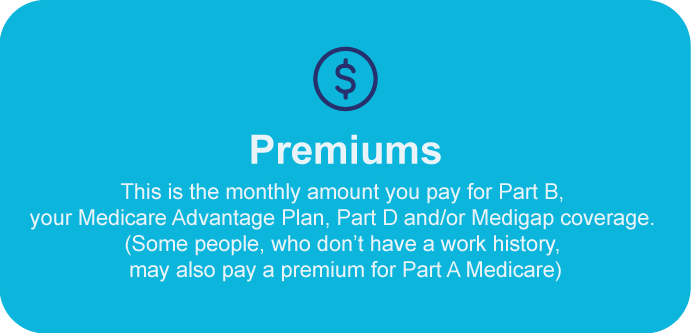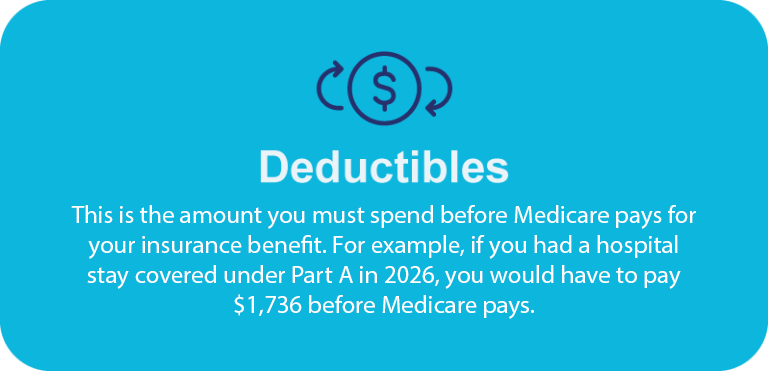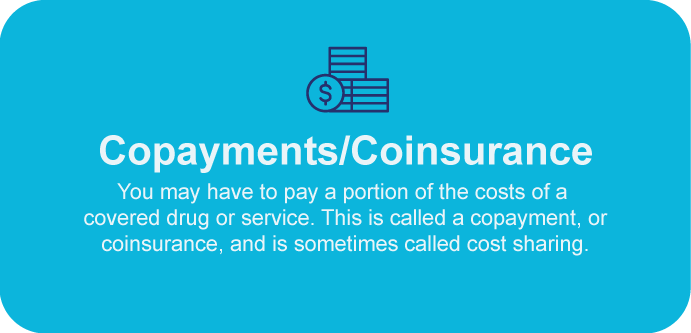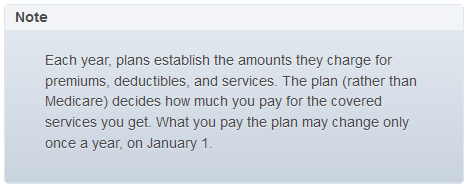Medicare covers a wide range of medical services. But Medicare is not free – it does not cover everything.
Anyone with Medicare will pay for a portion of their expenses, but what you pay will depend on the type of coverage that you have – Parts A & B (Original Medicare), Part C (a private Medicare Advantage plan), a Part D prescription drug plan and/or Medigap (supplemental coverage). What you pay will also depend on where you receive services and if you have other forms of insurance.
The Costs of Medicare Include:



How much does Part A cost?
You usually don’t pay a monthly premium for Medicare Part A (Hospital Insurance) coverage if you or your spouse paid Medicare taxes while working. This is sometimes called “premium-free Part A.”
If you buy Part A, you’ll pay either $311 or $565 each month in 2026 depending on how long you or your spouse worked and paid your Medicare taxes.
But, most people get premium-free Part A. You can get premium-free Part A at 65 if:
- You already get retirement benefits from Social Security or the Railroad Retirement Board.
- You’re eligible to get Social Security or Railroad benefits but haven’t filed for them yet.
- You or your spouse had Medicare-covered government employment.
If you’re under 65, you can get premium-free Part A if:
- You got Social Security or Railroad Retirement Board disability benefits for 24 months.
- You have End-Stage Renal Disease (ESRD) and meet certain requirements.
In most cases, if you choose to buy Part A, you must also have Medicare Part B (Medical Insurance) and pay monthly premiums for both.
GET HELP NAVIGATING THESE COSTS
How much does Part B cost?
Part B premiums
You pay a premium each month for Part B. If you get Social Security, Railroad Retirement Board, or Office of Personnel Management benefits, your Part B premium will be automatically deducted from your benefit payment. If you don’t get these benefit payments, you’ll get a bill.
Most people will pay the standard premium amount. However, if your modified adjusted gross income as reported on your IRS tax return from 2 years ago is above a certain amount, you may pay an Income Related Monthly Adjustment Amount (IRMAA). IRMAA is an extra charge added to your premium.
The standard Part B premium amount is $202.90 (or higher depending on your income). However, most people who get Social Security benefits will continue to pay the same Part B premium amount as they paid in 2026. You’ll pay a different premium amount if:
- You enroll in Part B for the first time in 2026.
- You don’t get Social Security benefits.
- You’re directly billed for your Part B premiums.
- You have Medicare and Medicaid, and Medicaid pays your premiums. (Your state will pay the standard premium amount of $202.90.)
- Your modified adjusted gross income as reported on your IRS tax return from 2 years ago is above a certain amount.
If you’re in 1 of these 5 groups, here’s what you’ll pay:
| If your yearly income in 2024 (for what you pay in 2026) was | You pay each month (in 2025) | ||
|---|---|---|---|
| File individual tax return | File joint tax return | File married & separate tax return | |
| $109,000 or less | $218,000 or less | $106,000 or less | $202.90 |
| above $109,000 up to $137,000 | above $218,000 up to $274,000 | Not applicable | $284.10 |
| above $137,000 up to $171,000 | above $274,000 up to $342,000 | Not applicable | $405.80 |
| above $171,000 up to $205,000 | above $342,000 up to $410,000 | Not applicable | $527.50 |
| above $205,000 and less than $500,000 | above $410,000 and less than $750,000 | above $109,000 and less than $391,000 | $649.20 |
| $500,000 or above | $750,000 or above | $391,000 or above | $689.90 |
Part B deductible & coinsurance
You pay $283 per year for your Part B deductible. After your deductible is met, you typically pay 20% of the Medicare-approved amount for most doctor services (including most doctor services while you’re a hospital inpatient), outpatient therapy, and durable medical equipment.
What you pay in a Medicare Advantage Plan – Part C
Your out-of-pocket costs in a Medicare Advantage Plan (Part C) depend on:
- Whether the plan charges a monthly premium.
- Whether the plan pays any of your monthly Medicare Part B (Medical Insurance) premium.
- Whether the plan has a yearly deductible or any additional deductibles.
- How much you pay for each visit or service (copayment or coinsurance). For example, the plan may charge a copayment, like $10 or $20 every time you see a doctor. These amounts can be different than those under Original Medicare.
- The type of health care services you need and how often you get them.
- Whether you go to a doctor or supplier who accepts assignment (if you’re in a PPO, PFFS, or MSA plan and you go out-of-network).
- Whether you follow the plan’s rules, like using network providers.
- Whether you need extra benefits and if the plan charges for it.
- The plan’s yearly limit on your out-of-pocket costs for all medical services.
- Whether you have Medicaid or get help from your state.

Get more cost details from your plan
If you’re in a Medicare plan, review the “Evidence of Coverage” (EOC) and “Annual Notice of Change” (ANOC) your plan sends you each fall. The EOC gives you details about what the plan covers, how much you pay, and more. The ANOC includes any changes in coverage, costs, or service area that will be effective in January.
GET HELP NAVIGATING THESE COSTS
Costs for Medicare drug coverage – Part D
Premium
Most Medicare Prescription Drug Plans charge a monthly fee that varies by plan. You pay this in addition to the Medicare Part B premium. If you belong to a Medicare Advantage Plan (Part C) or a Medicare Cost Plan that includes Medicare prescription drug coverage, the monthly premium you pay to your plan may include an amount for drug coverage.
Get your premium automatically deducted
Contact your drug plan (not Social Security) if you want your premium deducted from your monthly Social Security payment. Your first deduction will usually take 3 months to start, and 3 months of premiums will likely be deducted at once.
After that, only one premium will be deducted each month. You may also see a delay in premiums being withheld if you switch plans. If you want to stop premium deductions and get billed directly, contact your drug plan.
How much does Part D cost?
Most drug plans charge a monthly fee that varies by plan. Most people only pay their Part D premium. If you don’t sign up for Part D when you’re first eligible, you may have to pay a Part D late enrollment penalty.
If your modified adjusted gross income as reported on your IRS tax return from 2 years ago (the most recent tax return information provided to Social Security by the IRS) is above a certain limit, you may pay a Part D income-related monthly adjustment amount (Part D-IRMAA) in addition to your monthly plan premium. This extra amount is paid directly to Medicare, not to your plan.
| If your filing status and yearly income in 2024 was | |||
|---|---|---|---|
| File individual tax return | File joint tax return | File married & separate tax return | You pay each month (in 2025) |
| $109,000 or less | $218,000 or less | $109,000 or less | your plan premium |
| above $109,000 up to $137,000 | above $218,000 up to $274,000 | not applicable | $14.50 + your plan premium |
| above $137,000 up to $171,000 | above $274,000 up to $342,000 | not applicable | $37.50 + your plan premium |
| above $171,000 up to $205,000 | above $342,000 up to $410,000 | not applicable | $60.40 + your plan premium |
| above $205,000 and less than $500,000 | above $410,000 and less than $750,000 | above $109,000 and less than $391,000 | $83.30 + your plan premium |
| $500,000 or above | $750,000 or above | $391,000 or above | $91.00 + your plan premium |
Yearly deductible
This is the amount you must pay each year for your prescriptions before your Medicare Prescription Drug Plan begins to pay its share of your covered drugs.
Deductibles vary between Medicare drug plans. No Medicare drug plan may have a deductible of more than $615 in 2026. Some Medicare prescription drug plans do not have a deductible.
Copayments or coinsurance
The amount you pay for each of your prescriptions after you have paid the deductible (if your plan has one) is either a copayment or coinsurance. Some Medicare Prescription Drug Plans have different levels or ” tiers ” of copayments or coinsurance, with different costs for different types of drugs.
- With a copayment, you pay a set amount (like, $10) for all drugs on a tier. For example, you may pay a lower copayment for generic drugs than brand-name drugs.
- Coinsurance means you pay a percentage of the cost (like, 25%) of the drug.
Usually, the amount you pay for a covered prescription is for a one-month supply of a drug. However, you can request less than a one-month supply for most types of drugs. You might do this if you’re trying a new medication that’s known to have significant side effects or you want to synchronize the refills for all your medications. If you do this, the amount you pay is reduced based on the quantity you actually get. Talk with your doctor to get a prescription for less than a one-month supply.
GET HELP NAVIGATING THESE COSTS
Changes to the Coverage Gap
Brand-name prescription drugs
The coverage gap will be eliminated, meaning once you’ve spent $2,100 in out-of-pocket costs, you will no longer pay anything for covered prescriptions. This simplifies the process and reduces financial burdens for beneficiaries.
Generic drugs
Generic drug costs will fall under the $2,100 annual cap. After reaching the cap, you won’t have to pay for generic drugs for the rest of the year.
Items that count towards the coverage gap
- Your yearly deductible, coinsurance, and copayments
- The discount you get on brand-name drugs in the coverage gap
- What you pay in the coverage gap
Items that don’t count towards the coverage gap
- The drug plan premium
- Pharmacy dispensing fee
- What you pay for drugs that aren’t covered
Medicare Prescription Payment Plan (2025)
Starting in 2025, beneficiaries will have the option to spread their out-of-pocket costs into monthly payments over the calendar year, making medication expenses more predictable and manageable.
The Medicare Prescription Payment Plan will provide a new way to manage out-of-pocket costs for prescription drugs covered by your Medicare plan. This option allows you to spread your drug costs evenly across the calendar year (January–December), making payments more predictable. It’s available to anyone with a Medicare drug plan or a Medicare health plan that includes drug coverage, such as a Medicare Advantage Plan. All plans will offer this option, but participation is entirely voluntary.
If you choose to enroll, you’ll still pay your plan premium each month (if applicable), but instead of paying for prescriptions directly at the pharmacy, you’ll receive a bill from your health or drug plan to cover those costs. There’s no additional fee to use the Medicare Prescription Payment Plan. If you need more information about this benefit, please feel free to call us.
If you think you should get a discount
If you think you’ve reached the coverage gap and you don’t get a discount when you pay for your brand-name prescription, review your next “Explanation of Benefits” (EOB). If the discount doesn’t appear on the EOB, contact your drug plan to make sure that your prescription records are correct and up-to-date. Get your plan’s contact information from a Personalized Search (under General Search), or search by plan name. If your drug plan doesn’t agree that you’re owed a discount, you can file an appeal.
GET HELP NAVIGATING THESE COSTS
Costs if you get Extra Help
To check the level of Extra Help you’re entitled to, you’ll need to provide some information.
Documentation
Examples of documents you can send your plan include:
- A purple notice from Medicare that says you automatically qualify for Extra Help.
- A yellow or green automatic enrollment notice from Medicare.
- An Extra Help “Notice of Award” from Social Security.
- An orange notice from Medicare that says your copayment amount will change next year.
- If you have Supplemental Security Income (SSI), you can use your award letter from Social Security as proof that you have SSI.
You can also give your plan any of the following documents (called “Best Available Evidence”), which they must accept as proof that you qualify for Extra Help. If you don’t have or can’t find any of these documents, ask your plan for help.
Proof you have Medicaid and live in an institution or get home- and community-based services
- A bill from the institution (like a nursing home) or a copy of a state document showing Medicaid paid for your stay for at least a month.
- A print-out from your state’s Medicaid system showing that you lived in an institution for at least a month and that Medicaid paid for your stay.
- A document from your state that shows you have Medicaid and are getting home- and community-based services.
Other proof you have Medicaid
- A copy of your Medicaid card (if you have one).
- A copy of a state document that shows you have Medicaid.
- A print-out from a state electronic enrollment file or from your state’s Medicaid systems that shows you have Medicaid.
- Any other document from your state that shows you have Medicaid.
Once you give your plan this information, your plan must:
- Make sure you pay no more than the LIS drug coverage cost limit.
In 2026, costs are no more than $5.10 for each generic/$12.65 for each brand-name-covered drug.
- Contact Medicare so we can get proof that you qualify, if it’s available. You can expect your request to take anywhere from several days to up to 2 weeks to process, depending on the circumstances. Call 1-800-MEDICARE (1-800-633-4227).
GET HELP NAVIGATING THESE COSTS
Costs if you pay a late enrollment penalty
The late enrollment penalty is an amount added to your Medicare Part D monthly premium.
You may owe a late enrollment penalty if you go without a Medicare Prescription Drug Plan (Part D), or without a Medicare Advantage Plan (Part C) (like an HMO or PPO) or other Medicare health plan that offers Medicare prescription drug coverage, or without creditable prescription drug coverage for any continuous period of 63 days or more after your Initial Enrollment Period is over.
Learn how to avoid the late enrollment penalty.
How much is the Part D penalty?
The cost of the late enrollment penalty depends on how long you went without Part D or creditable prescription drug coverage.
Medicare calculates the penalty by multiplying 1% of the “national base beneficiary premium” ($38.99 in 2026) times the number of full, uncovered months you didn’t have Part D or creditable coverage. The monthly premium is rounded to the nearest $.10 and added to your monthly Part D premium.
The national base beneficiary premium may increase each year, so your penalty amount may also increase each year.
How do I know if I owe a penalty?
After you join a Medicare drug plan, the plan will tell you if you owe a penalty and what your premium will be. In general, you’ll have to pay this penalty for as long as you have a Medicare drug plan.
What if I don’t agree with the late enrollment penalty?
You may be able to ask for a “reconsideration.” Your drug plan will send information about how to request a reconsideration.
Complete the form, and return it to the address or fax number listed on the form within 60 days from the date on the letter stating you had to pay a late enrollment penalty. You should also send any proof that supports your case, like a copy of your notice of creditable prescription drug coverage from an employer or union plan.
Do I have to pay the penalty even if I don’t agree with it?
By law, the late enrollment penalty is part of the premium, so you must pay the penalty with the premium. You must also pay the penalty even if you’ve asked for a reconsideration. Medicare drug plans can disenroll members who don’t pay their premiums, including the late enrollment penalty portion of the premium.
How soon will I get a reconsideration decision?
In general, Medicare’s contractor makes reconsideration decisions within 90 days. The contractor will try to make a decision as quickly as possible. However, you may request an extension. Or, for good cause, Medicare’s contractor may take an additional 14 days to resolve your case.
What happens if Medicare’s contractor decides the penalty is wrong?
If Medicare’s contractor decides that all or part of your late enrollment penalty is wrong, the Medicare contractor will send you and your drug plan a letter explaining its decision. Your Medicare drug plan will remove or reduce your late enrollment penalty and will send you a letter that shows the correct premium amount and explains whether you’ll get a refund.
What happens if Medicare’s contractor decides the penalty is correct?
If Medicare’s contractor decides that your late enrollment penalty is correct, the Medicare contractor will send you a letter explaining the decision, and you must pay the penalty.
*Your actual drug plan costs will vary depending on:
- The drugs you use
- The plan you choose
- Whether you go to a pharmacy in your plan’s network
- Whether the drugs you use are on your plan’s formulary
- Whether you get Extra Help paying your Medicare Part D costs
Look for specific Medicare drug plan costs, and then call the plans you’re interested in to get more details.
If you have limited income and resources, your state may help you pay for Part A and/or Part B. You may also qualify for Extra Help to pay for your Medicare prescription drug coverage.
GET HELP NAVIGATING THESE COSTS
Explore Medigap Costs
Medicare doesn’t pay any of the costs for you to get a Medigap policy. You have to pay the premiums for a Medigap policy.
Medigap helps pay your Part B bills
In most Medigap policies, when you sign the Medigap insurance contract you agree to have the Medigap insurance company get your Part B claim information directly from Medicare, and then they pay the doctor directly. Some Medigap insurance companies also provide this service for Part A claims.
If your Medigap insurance company doesn’t provide this service, ask your doctors if they “participate” in Medicare. This means that they “accept assignment” for all Medicare patients. If your doctor participates, the Medigap insurance company is required to pay the doctor directly if you request.
Compare the costs of Medigap plans
Insurance companies may charge different premiums for the same exact policy. As you shop for a policy, be sure you’re comparing the same policy (for example, compare Plan A from one company with Plan A from another company).
In some states, you may be able to buy another type of Medigap policy called Medicare SELECT. If you buy a Medigap SELECT policy, you have the right to change your mind within 12 months and switch to a standard Medigap policy.
Calculating your costs
Make sure to compare your options on the basis of total yearly costs, adding up premiums and copays you anticipate for your level of coverage. You may have an unanticipated medical event and want to be prepared to handle it financially. If you have limited income or resources, you may qualify for help with costs.

